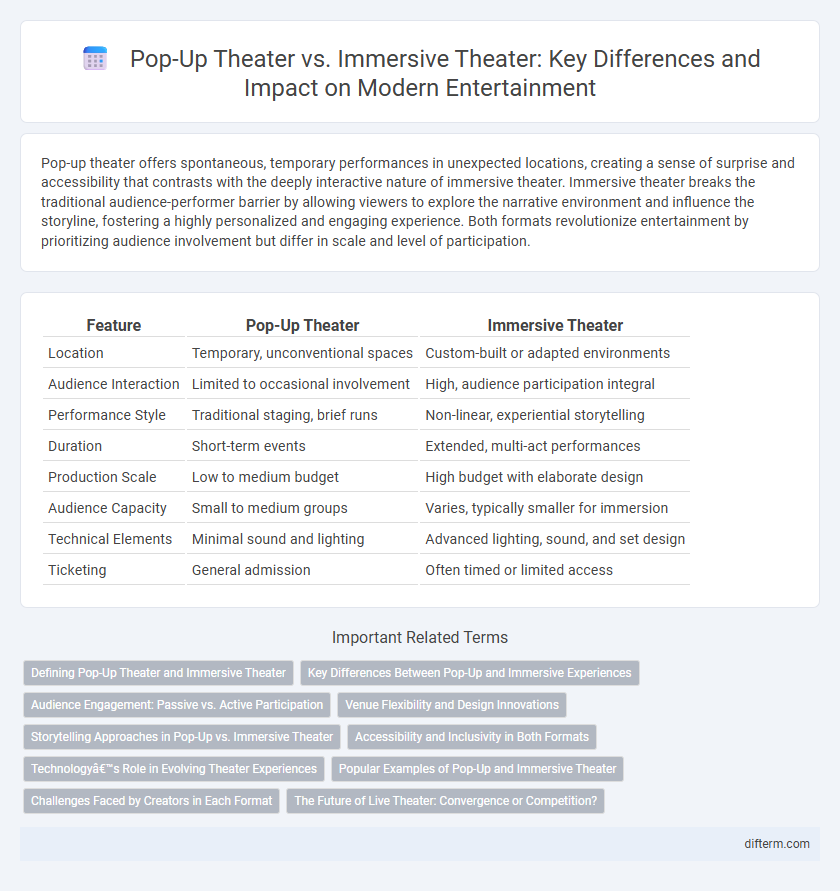Pop-up theater offers spontaneous, temporary performances in unexpected locations, creating a sense of surprise and accessibility that contrasts with the deeply interactive nature of immersive theater. Immersive theater breaks the traditional audience-performer barrier by allowing viewers to explore the narrative environment and influence the storyline, fostering a highly personalized and engaging experience. Both formats revolutionize entertainment by prioritizing audience involvement but differ in scale and level of participation.
Table of Comparison
| Feature | Pop-Up Theater | Immersive Theater |
|---|---|---|
| Location | Temporary, unconventional spaces | Custom-built or adapted environments |
| Audience Interaction | Limited to occasional involvement | High, audience participation integral |
| Performance Style | Traditional staging, brief runs | Non-linear, experiential storytelling |
| Duration | Short-term events | Extended, multi-act performances |
| Production Scale | Low to medium budget | High budget with elaborate design |
| Audience Capacity | Small to medium groups | Varies, typically smaller for immersion |
| Technical Elements | Minimal sound and lighting | Advanced lighting, sound, and set design |
| Ticketing | General admission | Often timed or limited access |
Defining Pop-Up Theater and Immersive Theater
Pop-up theater refers to temporary performance spaces that appear unexpectedly in unconventional locations, creating spontaneous theatrical experiences that blend closely with their environment. Immersive theater immerses the audience in the narrative by allowing them to move freely within the performance space and interact directly with actors, often dissolving the traditional stage-audience separation. Both formats challenge conventional theater norms, but pop-up theater emphasizes site-specific surprise, while immersive theater prioritizes participant engagement and sensory involvement.
Key Differences Between Pop-Up and Immersive Experiences
Pop-up theater offers temporary, site-specific performances often set in unconventional locations that emphasize surprise and novelty, creating a unique event-based atmosphere. Immersive theater, however, fully engages the audience by dissolving traditional stage boundaries, allowing viewers to interact directly with performers and narrative elements for a personalized storytelling experience. Key differences include pop-up theater's transient setup aimed at accessibility and spectacle, versus immersive theater's intricate, continuous environments designed for deep audience participation and emotional immersion.
Audience Engagement: Passive vs. Active Participation
Pop-up theaters offer a more passive audience experience, where viewers typically observe the performance from fixed seating or a designated area, maintaining a traditional spectator role. Immersive theaters engage the audience actively by breaking the fourth wall, allowing participants to explore the environment, interact with actors, and influence the narrative. This shift from passive observation to active immersion significantly enhances emotional connection and personal involvement in the storytelling process.
Venue Flexibility and Design Innovations
Pop-up theater offers unmatched venue flexibility by transforming unconventional spaces into temporary performance sites, allowing productions to adapt quickly to different locations and audience sizes. Immersive theater emphasizes design innovations through meticulously crafted environments that blur the line between actors and audiences, creating fully interactive experiences that engage multiple senses. Both formats push creative boundaries, but pop-up theater prioritizes agile spatial use, while immersive theater focuses on elaborate, narrative-driven set designs.
Storytelling Approaches in Pop-Up vs. Immersive Theater
Pop-up theaters utilize flexible, transient spaces to create spontaneous storytelling experiences, often relying on minimalistic sets and audience proximity to evoke emotional intimacy. Immersive theaters engage audiences by surrounding them with rich, interactive environments that blur the line between performers and spectators, enhancing narrative depth through multisensory stimulation. Both approaches prioritize active audience participation but differ in spatial dynamics and sensory engagement to shape unique storytelling journeys.
Accessibility and Inclusivity in Both Formats
Pop-up theater offers high accessibility by utilizing temporary, unconventional spaces that attract diverse audiences and reduce barriers to entry. Immersive theater emphasizes inclusivity through personalized, interactive experiences that engage participants in multisensory storytelling, often adapting to different abilities and promoting representation. Both formats innovate in audience engagement, yet pop-up theater excels in physical accessibility while immersive theater prioritizes experiential inclusivity.
Technology’s Role in Evolving Theater Experiences
Pop-up theaters utilize movable stages and augmented reality to create spontaneous entertainment spaces, allowing audiences to engage in dynamic environments tailored to each performance. Immersive theaters integrate advanced projection mapping, spatial audio, and interactive sensors to fully surround viewers, fostering a participatory experience that blurs the line between actors and spectators. Emerging technologies like virtual reality and AI-driven narratives further revolutionize these formats, enhancing personalization and transforming traditional theater into multidimensional, responsive experiences.
Popular Examples of Pop-Up and Immersive Theater
Popular examples of pop-up theater include "Sleep No More" by Punchdrunk, which transforms unconventional spaces into interactive performance venues, and "Then She Fell," offering intimate, site-specific storytelling experiences. Immersive theater productions like "The Great Gatsby" by Immersive Gatsby recreate the Roaring Twenties with audience participation, while "The Drowned Man" by Punchdrunk combines elaborate set designs with multi-sensory engagement. Both pop-up and immersive theaters push the boundaries of traditional stagecraft by fostering active audience involvement and dynamic environments.
Challenges Faced by Creators in Each Format
Pop-up theater creators often face logistical challenges such as securing unconventional spaces and adapting set designs to unpredictable environments, which demand flexibility and innovative problem-solving. Immersive theater directors confront complexities in choreographing audience interaction while maintaining narrative coherence and ensuring safety amid multi-sensory experiences. Both formats require balancing artistic vision with practical constraints to deliver engaging, memorable performances.
The Future of Live Theater: Convergence or Competition?
Pop-up theater and immersive theater represent innovative directions in live performance, each transforming audience engagement through unconventional spaces and interactive storytelling. Pop-up theater offers flexibility by activating unexpected venues for temporary shows, while immersive theater creates fully enveloping environments that blur boundaries between actors and spectators. The future of live theater may witness convergence, blending pop-up's mobility with immersive's experiential depth to redefine theatrical consumption.
pop-up theater vs immersive theater Infographic

 difterm.com
difterm.com